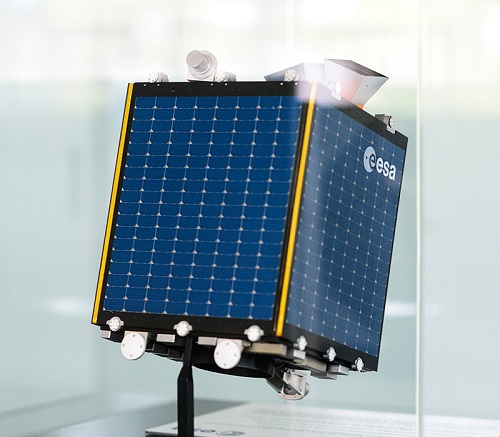
ESA Redu is not just a centre for education in space research, based in the Belgian Ardennes. It is also a European earth observation and solar observation station, and is involved in radio navigation and space cybersecurity. As the station has been connected to the Belnet network since 2014, we spoke to its director, Jean-Luc Trullemans, to discuss Belnet's involvement in current and future projects.
ESA Redu has been connected to Belnet since 2014, why did you opt for our network back then?
In 2014, the centre was mainly focused on small satellite operations and transferring this data to end-users. As our business was growing strongly, we needed more internet bandwidth. So we opted for Belnet.
What type of line do you use?
A line with 1 Gbit/s uplink downlink bandwidth (uplink and downlink between a satellite and a ground station) carried by a single mode Sofico fiber used by MOI-IT (Mission Operations IT) and the Proba mission for Internet access only.
 Proba is the family of earth observation satellites developed by Belgium, which we have historically operated from Redu. It all started with Proba-1, the first satellite to be launched some twenty years ago. It is still in operation despite its obsolescence. We are awaiting the launch of Proba-3 and Proba-V, which will comprise 12-unit cubesats (miniature cubic satellites) also operated from Redu.
Proba is the family of earth observation satellites developed by Belgium, which we have historically operated from Redu. It all started with Proba-1, the first satellite to be launched some twenty years ago. It is still in operation despite its obsolescence. We are awaiting the launch of Proba-3 and Proba-V, which will comprise 12-unit cubesats (miniature cubic satellites) also operated from Redu.
Do you have any other operations being carried out at Redu?
In terms of projects that are big data producers and require more bandwidth, the Hera mission, whose Mission Operation Centre will be in Redu, is linked to NASA. Last year, NASA sent a kinetic impactor to impact and deflect a meteorite passing close to Earth. The agency's mission is to observe the effect of this impact. This is a key mission for us, with high added value, but also high visibility. Which is very interesting for Redu and for Belgium.
We are also operating on behalf of EUSPA (the European Union Space Programme Agency). These operations mainly involve radio navigation via the European Galileo project. Part of the ground segment of this project is at Redu. An IOT antenna enables us to measure the quality of the signal emitted by the satellite.
This more robust radio navigation service is available to the member states of the European Union.
Next to this antenna is a Telemetry, Tracking and Command station (TT&C station). This is used to return a satellite to its working orbit. There are 8 in the world, one of which is at Redu.
We also host the space weather data center, and the data is sent to the IRM platform in Uccle, where it is processed.
Finally, our education division (from primary school to PhD students) is set to grow significantly. The range of training courses on offer will be multiplied by 2. This is a continuation of the support provided by the Belgian delegation within the Union.
 How is the data communicated to end-users? Is it all carried by the Belnet network?
How is the data communicated to end-users? Is it all carried by the Belnet network?
The satellites are connected to the terrestrial antennas at Redu, but also to the Mission Operation Centre, which is responsible for either downlinking the data produced by the satellites or uplinking the instructions sent to the satellites. The data is then communicated to end-users via Belnet's connectivity or the traditional Internet, depending on the status of their organisations. This is the case, for example, for space weather data that we send to the IRM via Belnet connectivity. For end-users in industry, things are different, because they are not connected to your network.
ESA is also a centre of excellence for space cybersecurity. Could you tell us a bit more about it?
This centre of excellence is due to be made available to Member States and the first deliverables are expected at the end of this year. This infrastructure is really being developed for space applications. So it's very interesting to be connected to Belnet via fibre, because we're in the process of setting up a community of users, and several Belgian administrations are very interested in joining.
Alongside the centre of excellence, a complementary monitoring centre will also be available. This SOC (Security Operations Centre) will aim to prevent anomalies as early as possible and will be fed by the centre of excellence. Once again, there is strong interest from the same organisations from the academic and administrative worlds in Belgium and abroad.
How will ESA and BeQCI fit together in the future?
We work with the BeQCI consortium, which includes Belnet and IMEC. We are in a highly technical phase and our facility manager and IT manager are in regular contact with Belnet's technicians. For my part, because my role is more strategic, I ensure that the security guidelines and policies of each organisation taking part in the project are respected.
In addition, we are involved in the INT-QKD project, which brings together several space agencies. We are involved in quantum, cybersecurity and encryption key distribution. This project will create an optical link between a satellite equipped with a laser and a telescope based in Redu.
This activity has been underwritten by Belspo and so this architecture will be connected to the BeQCI quantum network. So the BeQCI (which is part of the EURO QCI) and INT-QKD will fit together over the next few years.